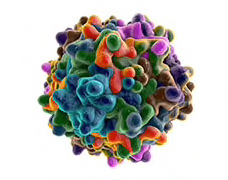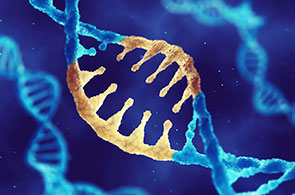A critical inflection point that drives the efficacy of a gene therapy is the delivery of the therapeutic gene into the target cell. During the past few decades, major advances have been made in gene delivery vector technologies, specifically in terms of therapeutic gene transfer vector design for safety and regulatory compliance.
Adeno-associated viruses (AAV) have emerged as one of the most significant viral vector delivery tools for use in gene therapies because of their non-pathogenicity to humans, ability to infect a broad range of cells and overall safety.
The cell and gene therapy landscape is growing rapidly, with representatives from the US Food and Drug Administration (FDA) and the European Medicines Agency (EMA) both predicting an approval rate of 10–20 cell and gene therapies per year by 2025.1
There are currently two FDA-approved AAV-based gene therapies available, Luxturna (Spark Therapeutics), approved in 2017 to treat a rare inherited retinal dystrophy, and Zolgensma (Novartis), approved in 2019 for spinal muscular atrophy. Continuous innovation around AAV manufacturing and therapeutic efficacy will be critical drivers for development and approval of more AAV-based gene therapies as this field continues to expand.
The impact of scalability
Gene therapies typically require a highly concentrated drug product, which requires manufacturers to optimise their production processes to achieve the highest production efficiencies possible.
To date, most gene therapy applications target rare diseases; however, the success achieved by both approved therapies, as well as those in the clinical pipeline, has expanded their application to larger patient populations and a greater number of diseases, including haemophilia and neurological eye diseases.
Treating larger cohorts of patients will require infrastructure and technologies to allow for scale-up of AAV production to meet future demands.
Critical barriers to manufacturing clinically compliant AAV vectors include high costs, scalability and extended manufacturing lead times owing to the lengthy production process.
Optimisation of the AAV vector production process remains a critical focus area of innovation in an effort to not only increase the production efficiency of the manufacturing process, but also to drive down costs.
This efficiency will, in turn, reduce the overall cost of the final gene therapy products, driving patient accessibility of these groundbreaking treatments. A key part of this optimisation is the scalability of the manufacturing process.
Implementing scalable AAV production solutions
Standardisation and reproducibility are key to scaling processes. During the upstream viral production steps, the viral packaging plasmids and gene of interest are delivered into a host production cell line.
Both mammalian and insect cell lines are commonly used as a platform for viral production. In the case of insect cells, undefined cell media components, such as yeastolate, can make it difficult to achieve reproducibility of performance.
With mammalian cell culture, optimal culture conditions often include the addition of serum or additives that are not ideal when an animal-origin-free process is preferred (or is the goal).
Within the regulated space of clinical vector manufacturing, scientists are increasingly turning to complete systems for chemically defined medium and protein expression enhancers that scale from early discovery to large-scale production. These complete production solutions are typically faster than standard protocols and are designed to be scalable.
Until recently, downstream purification processes had relied on the tools used in academia, where much of the research and discovery for gene therapies has taken place. These tools may be suited for the small-scale work of academics, but not for commercial manufacturing.

Solutions for AAV downstream purification are becoming more scalable, allowing manufacturers to overcome the key challenges associated with AAV purification, including the high degree of variation from the upstream process, increased impurity burden owing to cell lysis and different clarification strategies.
Developers have turned to affinity chromatography as the first post-clarification step for AAV downstream processing. The latest affinity resins can accommodate a wide range of upstream processes and AAV serotypes while allowing developers to balance process design with respect to ease of scalability, increasing productivity and enabling simplification via “platformability.”
Owing to the nature of AAV production, the burden of host cell-based impurities going into downstream purification is higher than that of monoclonal antibodies or recombinant proteins.
Developers should consider implementing affinity chromatography as early as possible to remove process impurities, including host cell proteins and DNA at an early stage before reaching later chromatography steps (such as ion exchange).
High purity levels and high yields can then be achieved in a single step. Affinity chromatography also concentrates the AAV product without needing to make major adjustments to the load materials going into the column.
Easing regulatory burden with analytics
Ultimately, process development can only be as effective as the analytics allow. Quality control testing, including Mycoplasma and residual host cell DNA testing, can help developers to leverage analytical insight to streamline their processes while proving their product meets regulatory standards.
Regulators call for Mycoplasma testing at specific points in the cell culture when a contaminant would be most detectable. For AAV manufacturing, it is recommended that Mycoplasma testing is performed at the end of the cell culture process, at the bioreactor harvest and prior to purification of the recombinant AAV.
Rather than relying on extended period or 28-day culture-based testing for Mycoplasma, developers can use rapid tests (such as PCR).2
Real-time PCR based assays also provide an accurate and sensitive testing method for residual host cell and vector DNA. This should be conducted across the purification process to enable an understanding of the capability to clear host cell and associated vector DNA components at each step of the process.
The final dosage form of the AAV vector-based product must meet or exceed guidelines established by major regional and global regulatory agencies, including the FDA, EMA and the World Health Organization, as well as local regulatory jurisdictions.
The regulatory guidance from the FDA states that residual host cell DNA levels in final products be less than 10 nanograms per therapeutic dose from processes using continuous non-tumorigenic cells.
For those cases when the residual DNA levels approach the specified limit, the DNA size should be less than 200 base pairs.3
It is now understood that AAVs can package fragments of host cell DNA and/or DNA from vectors used in the recombinant AAV process. To fully understand that component, manufacturers may look toward emerging analytical technologies, such as the use of next generation sequencing (NGS) to characterise and identify residual DNA if present in the product at the end of purification.
By completing a full genomic analysis of the purified virus, this technology can provide a more complete picture of AAV genomic DNA and residual host cell or vector DNA that may be present in the final product.
This application is just beginning to be explored but will likely become more routine as labs adopt this technology, regulatory expectations continue to rise and more detailed documentation is required.
Demand for AAV-based clinical therapies will continue to grow
As the anticipated growing number of AAV-based therapies enter the clinical pipeline, developers will need to consider how best to optimise their manufacturing processes to meet demand for large-volume, high-titre AAV vector preparations and the subsequent handling of large-scale downstream workflow steps — while simultaneously maintaining safety and quality standards to meet regulatory requirements.
To achieve this, innovations within this space will need to focus on tools that drive the scalability of the upstream and downstream manufacturing process.
End-to-end viral production workflows that can transition seamlessly from small-scale early discovery to large-scale commercial manufacturing will enable new heights of AAV production scalability.
References
- www.fda.gov/news-events/press-announcements/statement-fda-commissioner-scott-gottlieb-md-and-peter-marks-md-phd-director-center-biologics.
- L. Dreolini, et al., “A Rapid and Sensitive Nucleic Acid Amplification Technique for Mycoplasma Screening of Cell Therapy Products,” Molecular Therapy - Methods & Clinical Development 17, 393–399 (2020): https://doi.org/10.1016/j.omtm.2020.01.009.
- Center for Biologics Evaluation and Research, “Testing of Retroviral Vector-Based Human Gene Therapy Products for Replication Competent Retrovirus During Product Manufacture and Patient Follow-Up,” 2020: www.fda.gov/media/113790/download.




